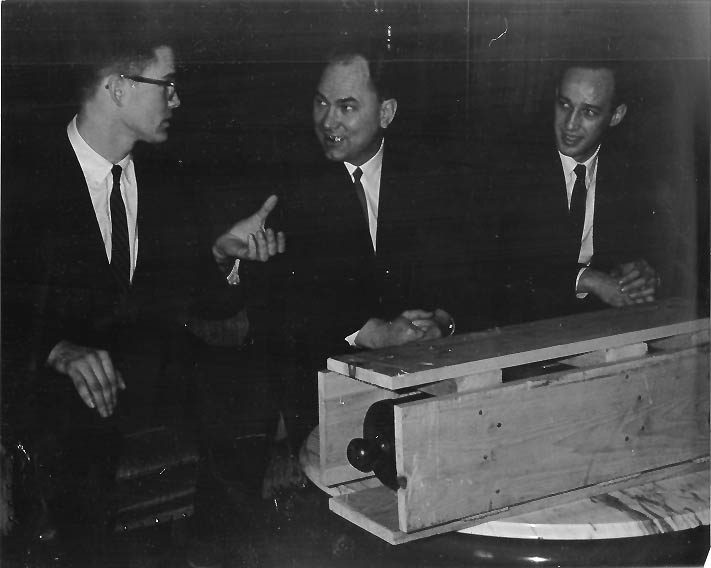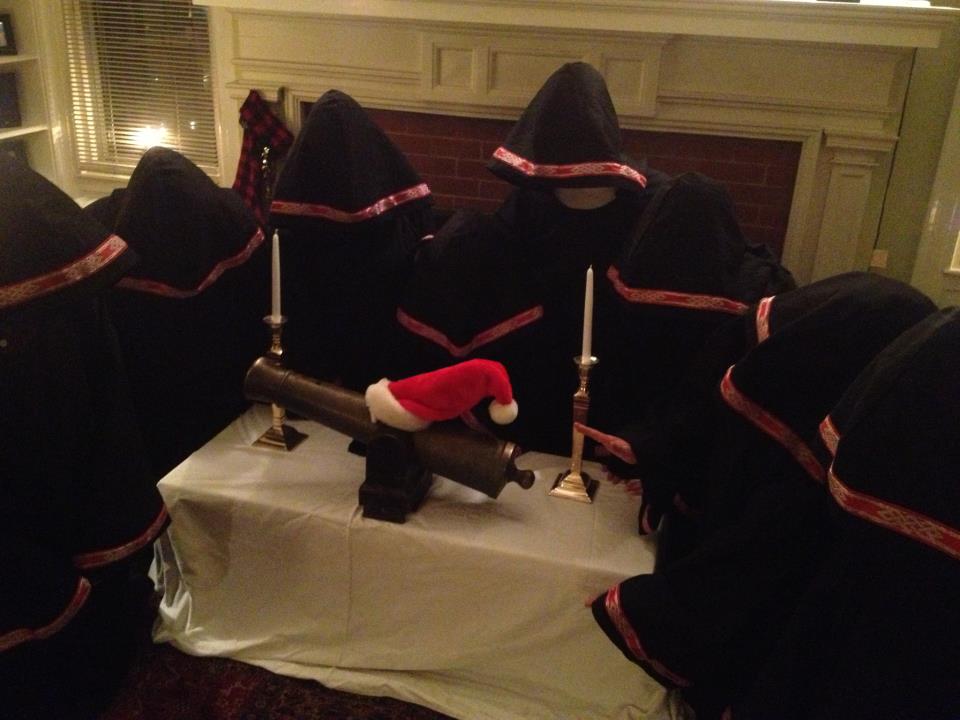
Picture this: it’s midnight on Friday, Feb. 22, 1867. Your knees are aching; dirt and blood—not entirely your own—cake your breeches. Your cheeks sting with the cold air of a late winter blizzard, and your grandfather’s wool coat is not faring well in combat. Jameson, the first-year who shares a pew with you during your several-times-weekly Methodist services, lays beneath your leather boot. Atop the hill, just a short fifteen paces from your position, your classmates furiously ram gunpowder into the touchhole of the Douglas Cannon.
It happens in slow motion. First-years sprinting toward the hill, sophomores screaming and…BOOM! The smell of burnt gunpowder fills your nostrils and your ears ring. It’s all over. You’ve won. Cheers and wails rip through the crowd as you regain your hearing. Jameson rolls over in pain as you lift your boot and run over to celebrate with your colleagues.
The First Era (1840–1916)
This is the experience of the Cannon Scraps, a long-abandoned Wesleyan tradition. In 1867, the Douglas Cannon, a 140-pound brass gun given to the school by the W&B Douglas Company, emerged as the focal point of the annual Scrap. The game, essentially a lawless brawl between underclassmen aiming to steal and fire the cannon before the other class, would remain largely unregulated, and quite violent, until 1901, when The Wesleyan Argus would publish the first ever set of rules.
In their efforts to circumvent the cruel hand of the (ultimately rational) school administration, the student body fully embraced the mischief and turpitude exemplified by the burgeoning tradition. Intricate, complex, and logistically taxing schemes emerged. From decoy cannons to well-placed bribes, the early tradition of the Douglas Cannon was nearly eradicated by the early-20th-century standard for excessive fun. In 1916, the first era of the Douglas Cannon tradition came to a close. Having survived a journey beneath the waters of the Connecticut River and a violent encounter with the Middletown Fire Department, the Wesleyan community deemed the cannon ripe for retirement.
The Second Era (1931, 1957–2008)
For years, the cannon lay remiss, filled with lead and quietly resting between South College and Memorial Chapel (where you can still see its old pedestal). Its plaque read:
BORN IN OBSCURITY – REARED IN STRIFE
TEMPERED BY TRAVEL – NEVER DISCOURAGED
HOME AT LAST
October, 1931
And yet, despite the end of an era, a new one began. Students, itching to branch out beyond their boy-next-door liberal arts degrees, began to dabble in thievery. In 1957, a few nay-saying undergraduates hand-sawed the cannon free and made off with it. Here starts the real, excessive fun. Some call it the thrill of the chase; 20th century Wesleyan students called it the thrill of the steal-and-return and steal-again and so on and so forth.
It’s been rumored to have traveled to the White House (as far as the gate, at least), Venezuela, and Paris. It’s literally seen war, famine, and pestilence. It’s been in the hands of diplomats, dignitaries, dastardly university presidents, and a CIA agent to boot. The Cannon’s mythic exploits from this era are well-documented. Some of the alleged highlights are as follows:
- Members of the class of 1961 hand-delivered the cannon to the USSR’s Delegation to the United Nations as a gesture of goodwill between the superpowers.
- Former Dean of Students Mark Barlow would leave flashlights in his house to deter students from breaking in and stealing the cannon under candlelight, posing a fire risk. “We had to leave flashlights around so that they wouldn’t use matches and start a fire,” Barlow said in an interview with The Argus.
- In 1967, the cannon appeared in the New York office of the Managing Editor of Life Magazine.
- It made a reappearance in 1967 for the inauguration of President Victor Butterfield, allegedly under the stewardship of a secret cannon society: Cannon Retrievers United South Under Heaven (CRUSH).
- The cannon made a brief appearance before the gates of the White House as a present for President Nixon, in protest of the Vietnam War, before being retrieved by Connecticut congressmen, notably including Emilio Daddario ’39.
- In 1981, audience members of the sesquicentennial anniversary celebration report watching President Colin Campbell’s wife Nancy Campbell cut into a cake, only to find the cannon inside.
- Doug Addicts, another rumored cannon society, boasted pictures of the cannon in Europe and elsewhere. Doug—the cannon—having landed his name on a postcard sent to the desk of the Wesleyan president, returned to the States in 1989, riddled with Venezuelan stamps.
- After being requested from an art class in 1998, the cannon was gifted to students and one professor Jeffrey Schiff, purportedly delivered by members of the administration itself (who would deny these allegations).
While the above list may appear superfluous in length, these stories reflect just a small fraction of Douglas Cannon lore from this era. From 1957 to 2008, the paper trail of the Cannon and its travels remains largely intact, stored in the Wesleyan Special Collections and Archives. Make an appointment; it’s worth it.
Notably, the second era of the Douglas Cannon signified a major shift in community attitude towards the tradition. University Presidents and their administrations began to co-opt the cannon as a powerful piece of narrative, a physical embodiment of the Wesleyan spirit of evolution and progress.
Moreover, students began to organize CRUSH and the Doug Addicts. While CRUSH reached its zenith in the 1960s and 1970s, the Addicts are largely associated with the Cannon’s later exploits, including its widely rumored world travel in the late 1980s. Although the emergence of societies mediated student interactions with the Douglas Cannon, it served to further cement the cannon as an object of legend.
While the Douglas Cannon website—the most accessible source on the tradition’s history—ended abruptly in 2000, sparing references to the cannon continue to appear in print. While picking a solidified end date for the Second Tradition becomes increasingly abstract, the candor and tone of the cannon appears to make a marked shift at the beginning of the 21st century.
The Third Era: The Phantom Menace (2008–Present)
Contemporary reporting on the Douglas Cannon has largely failed to demarcate the emergence of a new modern era: the phantom cannon. While the tradition of stealing and returning had remained largely unchanged, following the 2007–2008 academic year, the nature of these interactions have become phantasmic mirages, reported on via speculative connections posited by students doing their best to uncover a bygone history.

As early as 2000, there is a discursive distinction between the rich Cannon myths of the earlier eras and the sparse reporting of the modern era. For much of the early 2000s, an ad hoc student group, the Cannon Liberators Aiming West (CLAW) had possession of the cannon. In addition to their love of acronyms and cardinal directions, the group seemingly affirmed its mission by bringing “Doug” to St. Louis and even a Las Vegas Casino. A 2006 article in The Argus entitled “The saga continues: Douglas Cannon travels the hemispheres” by Editor-in-Chief Brian Colgan ’08 reports that, upon its return to campus in 2001, most students did not understand the cannon’s significance. While another article published by The Argus in 2015 confirms the existence of CLAW, the two writers reached drastically different conclusions: the former believing that the cannon was possessed by recent graduates, and the latter believing that it was in the hands of the administration.
In addition to the somewhat frequent articles written by The Argus, the Cannon has been documented by an inconsistent stream of communiqués between the Cannon’s holders and Wesleying, a student run blog that remained a prominent source of Wes lore well into the 2010s. One major deviation in the Douglas Cannon lore is the consistency and tangibility of information related to the administration’s relationship with the Cannon in contrast to that of the student body’s. While it is well documented that the administration (at least briefly) possessed the cannon during President Michael Roth’s 2007 Inauguration and the class of 1962’s 55th Year Reunion in 2017 (the class responsible for delivering the cannon to the USSR), the student turnover of the Cannon is nearly untraceable.
On the student side, the story continued to unfold up until 2018. Between early 2007 and 2018, Wesleying reported on nearly a dozen Douglas Cannon sightings, typically featuring the large gun surrounded by hooded individuals. The mystique of the Cannon was even neatly packaged—through a tacit link proposed by writers for The Argus—into a 2015 scandal surrounding Wes Unity, a now defunct student advocacy group who utilized the lore of the Cannon in its social media advertising. Realistically, the likelihood that this scandal is tied to the possession of the Cannon is next to none. Since 2018, the trail of the Douglas Cannon has gone cold. The elusive symbol of Wesleyan’s traditions and evolutions remains unheard and unaccounted for.
Despite how the tradition of the cannon harks back to student-led initiatives (the theft, the scraps, etc.), as traditions evolved and devolved, they enthralled students, administrators, and alumni alike. Recall student testimony to administration participation in the tradition of stealing and returning.
Despite widespread enjoyment and (excessive) fun, as the tradition stumbled into the late 20th century and 21st century, it gradually became esoteric. The cannon narrative slowly slipped further from the students, resigned to records and institutional knowledge. There emerged an inconsistency between the University’s past involvement and its current silence.
In 2018, the University released a tweet recalling the past of the cannon. “Help us bring it back home,” it read. Indeed, throughout the cannon’s history, the University has consistently tried to keep the gun in one place. Somehow, this exists in tandem with the alleged enthusiastic participation of administration.
So, where does this leave us? There was always a general cultural consensus to have good fun, flouting bureaucratic work to restrict the cannon to its purpose of sitting and looking stern. It has always been a Wesleyan cultural and moral tide to resist administrative buttoned-up control. Without this institutional knowledge, students cannot participate in the tradition realistically, and thus there is a certain responsibility laying with the administration.
If in the correct niche rumor-circulation circles, a student might hear the loose-lipped ramblings of Public Safety officers alleging the Douglas Cannon lies not with the student body or alumni, but instead within a rotating door of administrative actors. Whether it be the administration themselves who hoard the so-beloved (by the correct niche circle of students) cannon, or slow-moving-selfish alumni, or some apparition of a secret society, they have a duty to the spirit of Wesleyan to continue this tradition as we approach the bicentennial. This spirit is funded by all members of Wesleyan University who pass through and contribute to the fiber of this institution.
So, please, as we recall the almost-150th anniversary of the Cannon Scraps, do not disservice this community by holding the tradition of the Douglas Cannon hostage.
Amalie Little can be reached at alittle@wesleyan.edu.
A.J. Minzer can be reached at aminzer@wesleyan.edu.
“From the Argives” is a column that explores The Argus’ archives (Argives) and any interesting, topical, poignant, or comical stories that have been published in the past. Given The Argus’ long history on campus and the ever-shifting viewpoints of its student body, the material, subject matter, and perspectives expressed in the archived article may be insensitive or outdated and do not reflect the views of any current member of The Argus. If you have any questions about the original article or its publication, please contact Head Archivist Sam Hilton at shilton@wesleyan.edu.



Leave a Reply